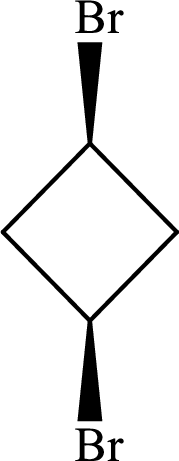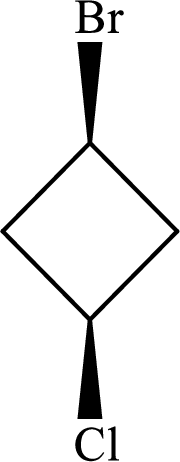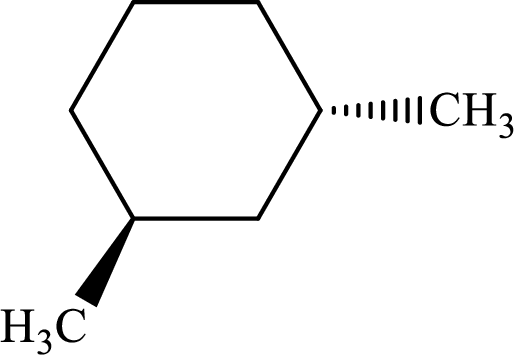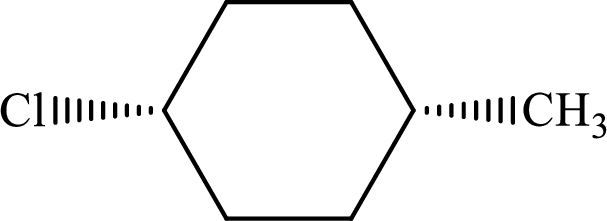
GENERAL, ORGANIC, BIOCHEM (ACCESS CARD)
10th Edition
ISBN: 9781260886023
Author: Denniston
Publisher: INTER MCG
expand_more
expand_more
format_list_bulleted
Concept explainers
Question
Chapter 10, Problem 10.86QP
(a)
Interpretation Introduction
Interpretation:
Given cycloalkane has to be named using

Concept Introduction:
IUPAC rules for naming cycloalkanes:
A common nomenclature of naming organic compounds has been developed by IUPAC. By usage of this nomenclature or rules, memorizing of names of organic compounds is not necessary.
- The number of carbon atoms present in the ring is counted and the name of the
alkane that has the same number of carbon atoms is given by adding prefix “cyclo-” to the alkane name. - If the ring is substituted, then the names of the group or atoms have to be placed before the name of cycloalkane. If only one substituent is present, then number is not required.
- If the ring contains more than one substituent, then the numbers has to be used in a way that it gives the lowest position for the substituents.
(b)
Interpretation Introduction
Interpretation:
Given cycloalkane has to be named using IUPAC nomenclature.

Concept Introduction:
Refer part (a).
(c)
Interpretation Introduction
Interpretation:
Given cycloalkane has to be named using IUPAC nomenclature.

Concept Introduction:
Refer part (a).
(d)
Interpretation Introduction
Interpretation:
Given cycloalkane has to be named using IUPAC nomenclature.

Concept Introduction:
Refer part (a).
Expert Solution & Answer
Want to see the full answer?
Check out a sample textbook solution
Students have asked these similar questions
What is the pH of a 1.0 L buffer made with 0.300 mol of HF (Ka = 6.8 × 10⁻⁴) and 0.200 mol of NaF to which 0.160 mol of NaOH were added?
Can I please get help with this.
Determine if the following salt is neutral, acidic or basic. If acidic or basic, write the appropriate equilibrium equation for the acid or base that exists when the salt is dissolved in aqueous solution. If neutral, simply write only NR. Be sure to include the proper phases for all species within the reaction. N₂H₅ClO₄
Chapter 10 Solutions
GENERAL, ORGANIC, BIOCHEM (ACCESS CARD)
Ch. 10.1 - Prob. 10.1QCh. 10.1 - Prob. 10.2QCh. 10.2 - Prob. 10.3QCh. 10.2 - Prob. 10.4QCh. 10.3 - Prob. 10.1PPCh. 10.3 - Prob. 10.5QCh. 10.3 - Prob. 10.6QCh. 10.3 - Prob. 10.2PPCh. 10.3 - Prob. 10.3PPCh. 10.3 - Heptane is a very poor fuel and is given a zero on...
Ch. 10.4 - Name each of the following cycloalkanes using...Ch. 10.4 - Prob. 10.6PPCh. 10.4 - Prob. 10.7PPCh. 10.6 - Write a balanced equation for the complete...Ch. 10.6 - Write a balanced equation for each of the...Ch. 10.6 - Prob. 10.8QCh. 10 - Prob. 10.9QPCh. 10 - Prob. 10.10QPCh. 10 - Prob. 10.12QPCh. 10 - Prob. 10.13QPCh. 10 - Prob. 10.14QPCh. 10 - Prob. 10.15QPCh. 10 - Prob. 10.16QPCh. 10 - Prob. 10.17QPCh. 10 - Prob. 10.18QPCh. 10 - Prob. 10.19QPCh. 10 - Prob. 10.20QPCh. 10 - Prob. 10.21QPCh. 10 - Describe the major differences between ionic and...Ch. 10 - For centuries, fishermen have used shark liver oil...Ch. 10 - Prob. 10.24QPCh. 10 - Prob. 10.25QPCh. 10 - Prob. 10.26QPCh. 10 - Prob. 10.27QPCh. 10 - Prob. 10.28QPCh. 10 - Prob. 10.29QPCh. 10 - Prob. 10.30QPCh. 10 - Prob. 10.31QPCh. 10 - Prob. 10.32QPCh. 10 - Prob. 10.33QPCh. 10 - Prob. 10.34QPCh. 10 - Prob. 10.35QPCh. 10 - Prob. 10.36QPCh. 10 - Prob. 10.37QPCh. 10 - Prob. 10.38QPCh. 10 - Prob. 10.39QPCh. 10 - Prob. 10.40QPCh. 10 - Prob. 10.41QPCh. 10 - Prob. 10.42QPCh. 10 - Prob. 10.43QPCh. 10 - Prob. 10.44QPCh. 10 - Prob. 10.45QPCh. 10 - Prob. 10.46QPCh. 10 - Prob. 10.47QPCh. 10 - Prob. 10.48QPCh. 10 - Prob. 10.49QPCh. 10 - Prob. 10.50QPCh. 10 - Prob. 10.51QPCh. 10 - Prob. 10.52QPCh. 10 - Prob. 10.53QPCh. 10 - Prob. 10.54QPCh. 10 - Prob. 10.55QPCh. 10 - Prob. 10.56QPCh. 10 - Prob. 10.57QPCh. 10 - Prob. 10.58QPCh. 10 - Prob. 10.59QPCh. 10 - Prob. 10.60QPCh. 10 - Prob. 10.61QPCh. 10 - Prob. 10.62QPCh. 10 - Prob. 10.63QPCh. 10 - Prob. 10.64QPCh. 10 - Prob. 10.65QPCh. 10 - Prob. 10.66QPCh. 10 - Prob. 10.67QPCh. 10 - Prob. 10.68QPCh. 10 - Prob. 10.69QPCh. 10 - Prob. 10.70QPCh. 10 - Prob. 10.71QPCh. 10 - Prob. 10.72QPCh. 10 - Prob. 10.73QPCh. 10 - Prob. 10.74QPCh. 10 - Prob. 10.75QPCh. 10 - Prob. 10.76QPCh. 10 - Are the following names correct or incorrect? If...Ch. 10 - In your own words, describe the steps used to name...Ch. 10 - Draw the structures of the following compounds....Ch. 10 - Prob. 10.80QPCh. 10 - Prob. 10.81QPCh. 10 - Prob. 10.82QPCh. 10 - Prob. 10.83QPCh. 10 - Prob. 10.84QPCh. 10 - Prob. 10.85QPCh. 10 - Prob. 10.86QPCh. 10 - Prob. 10.87QPCh. 10 - Draw each of the following...Ch. 10 - Prob. 10.89QPCh. 10 - Prob. 10.90QPCh. 10 - Which of the following names are correct and which...Ch. 10 - Which of the following names are correct and which...Ch. 10 - Prob. 10.93QPCh. 10 - Prob. 10.94QPCh. 10 - Prob. 10.95QPCh. 10 - Prob. 10.96QPCh. 10 - What are conformational isomers?
Ch. 10 - Prob. 10.98QPCh. 10 - Make a model of cyclohexane and compare the boat...Ch. 10 - Prob. 10.100QPCh. 10 - Prob. 10.101QPCh. 10 - Prob. 10.102QPCh. 10 - Prob. 10.103QPCh. 10 - Prob. 10.104QPCh. 10 - Prob. 10.105QPCh. 10 - Prob. 10.106QPCh. 10 - Prob. 10.107QPCh. 10 - Prob. 10.108QPCh. 10 - Prob. 10.109QPCh. 10 - Prob. 10.110QPCh. 10 - Prob. 10.111QPCh. 10 - Prob. 10.112QPCh. 10 - Prob. 1MCPCh. 10 - Prob. 2MCPCh. 10 - Prob. 3MCPCh. 10 - Indicate which of the following are true of...Ch. 10 - Prob. 7MCPCh. 10 - Prob. 8MCPCh. 10 - Prob. 9MCPCh. 10 - Prob. 10MCP
Knowledge Booster
Learn more about
Need a deep-dive on the concept behind this application? Look no further. Learn more about this topic, chemistry and related others by exploring similar questions and additional content below.Similar questions
arrow_back_ios
SEE MORE QUESTIONS
arrow_forward_ios
Recommended textbooks for you
 ChemistryChemistryISBN:9781305957404Author:Steven S. Zumdahl, Susan A. Zumdahl, Donald J. DeCostePublisher:Cengage Learning
ChemistryChemistryISBN:9781305957404Author:Steven S. Zumdahl, Susan A. Zumdahl, Donald J. DeCostePublisher:Cengage Learning ChemistryChemistryISBN:9781259911156Author:Raymond Chang Dr., Jason Overby ProfessorPublisher:McGraw-Hill Education
ChemistryChemistryISBN:9781259911156Author:Raymond Chang Dr., Jason Overby ProfessorPublisher:McGraw-Hill Education Principles of Instrumental AnalysisChemistryISBN:9781305577213Author:Douglas A. Skoog, F. James Holler, Stanley R. CrouchPublisher:Cengage Learning
Principles of Instrumental AnalysisChemistryISBN:9781305577213Author:Douglas A. Skoog, F. James Holler, Stanley R. CrouchPublisher:Cengage Learning Organic ChemistryChemistryISBN:9780078021558Author:Janice Gorzynski Smith Dr.Publisher:McGraw-Hill Education
Organic ChemistryChemistryISBN:9780078021558Author:Janice Gorzynski Smith Dr.Publisher:McGraw-Hill Education Chemistry: Principles and ReactionsChemistryISBN:9781305079373Author:William L. Masterton, Cecile N. HurleyPublisher:Cengage Learning
Chemistry: Principles and ReactionsChemistryISBN:9781305079373Author:William L. Masterton, Cecile N. HurleyPublisher:Cengage Learning Elementary Principles of Chemical Processes, Bind...ChemistryISBN:9781118431221Author:Richard M. Felder, Ronald W. Rousseau, Lisa G. BullardPublisher:WILEY
Elementary Principles of Chemical Processes, Bind...ChemistryISBN:9781118431221Author:Richard M. Felder, Ronald W. Rousseau, Lisa G. BullardPublisher:WILEY

Chemistry
Chemistry
ISBN:9781305957404
Author:Steven S. Zumdahl, Susan A. Zumdahl, Donald J. DeCoste
Publisher:Cengage Learning

Chemistry
Chemistry
ISBN:9781259911156
Author:Raymond Chang Dr., Jason Overby Professor
Publisher:McGraw-Hill Education

Principles of Instrumental Analysis
Chemistry
ISBN:9781305577213
Author:Douglas A. Skoog, F. James Holler, Stanley R. Crouch
Publisher:Cengage Learning

Organic Chemistry
Chemistry
ISBN:9780078021558
Author:Janice Gorzynski Smith Dr.
Publisher:McGraw-Hill Education

Chemistry: Principles and Reactions
Chemistry
ISBN:9781305079373
Author:William L. Masterton, Cecile N. Hurley
Publisher:Cengage Learning

Elementary Principles of Chemical Processes, Bind...
Chemistry
ISBN:9781118431221
Author:Richard M. Felder, Ronald W. Rousseau, Lisa G. Bullard
Publisher:WILEY
Chapter 4 Alkanes and Cycloalkanes Lesson 2; Author: Linda Hanson;https://www.youtube.com/watch?v=AL_CM_Btef4;License: Standard YouTube License, CC-BY
Chapter 4 Alkanes and Cycloalkanes Lesson 1; Author: Linda Hanson;https://www.youtube.com/watch?v=PPIa6EHJMJw;License: Standard Youtube License